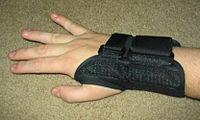
Exercise‐induced hypoalgesia in young adult females with long‐standing patellofemoral pain – A randomized crossover study
Sign Up to like & getrecommendations! Published in 2019 at "European Journal of Pain"
DOI: 10.1002/ejp.1452
Abstract: Patellofemoral pain (PFP) is a common knee pain condition where hip and knee exercises help improve treatment outcomes. This study compared the acute effect of hip versus knee exercises on anti‐nociceptive and pro‐nociceptive mechanisms in… read more here.
Keywords: exercise induced; induced hypoalgesia; females long; patellofemoral pain ... See more keywords

Response profile in a rat model of exercise‐induced hypoalgesia is associated with duloxetine, pregabalin and diclofenac effect on constriction‐induced neuropathy
Sign Up to like & getrecommendations! Published in 2022 at "European Journal of Pain"
DOI: 10.1002/ejp.2044
Abstract: Exercise is a known trigger of the inhibitory pain modulation system and its analgesic effect is termed exercise‐induced hypoalgesia (EIH). Previous studies have demonstrated that rats with deficient analgesic response following exercise develop more significant… read more here.
Keywords: effect; induced hypoalgesia; exercise induced; response ... See more keywords

Lack of Exercise‐Induced Hypoalgesia to Repetitive Back Movement in People with Chronic Low Back Pain
Sign Up to like & getrecommendations! Published in 2019 at "Pain Practice"
DOI: 10.1111/papr.12804
Abstract: To investigate whether people with chronic low back pain (LBP) show dysfunctional exercise‐induced hypoalgesia (EIH) in response to repeated contractions of their back muscles during a lifting task. read more here.
Keywords: people chronic; back pain; exercise induced; low back ... See more keywords

The Association of Psychosocial Factors and Exercise‐Induced Hypoalgesia in Healthy People and People With Musculoskeletal Pain: A Systematic Review
Sign Up to like & getrecommendations! Published in 2020 at "Pain Practice"
DOI: 10.1111/papr.12894
Abstract: Exercise, a cornerstone in current treatments for people with musculoskeletal pain, elicits a phenomenon called exercise‐induced hypoalgesia (EIH), which may result in reduced pain intensity and/or increased pain thresholds. However, EIH can be impaired in… read more here.
Keywords: psychosocial factors; musculoskeletal pain; people musculoskeletal; exercise induced ... See more keywords

Exercise-induced hypoalgesia after aerobic versus neck-specific exercise in people with acute/subacute whiplash-associated disorders: protocol for a randomised controlled trial
Sign Up to like & getrecommendations! Published in 2022 at "BMJ Open"
DOI: 10.1136/bmjopen-2022-061679
Abstract: Introduction A disturbance in exercise-induced hypoalgesia (EIH) has been observed in patients with chronic whiplash-associated disorders (WAD). Yet, no studies have examined whether EIH occurs in people with acute/subacute WAD. This study will determine whether… read more here.
Keywords: people acute; induced hypoalgesia; trial; acute subacute ... See more keywords

Plastic changes in amygdala subregions by voluntary running contribute to exercise-induced hypoalgesia in neuropathic pain model mice
Sign Up to like & getrecommendations! Published in 2020 at "Molecular Pain"
DOI: 10.1177/1744806920971377
Abstract: Physical exercise has been established as a low-cost, safe, and effective way to manage chronic pain, but exact mechanisms underlying such exercise-induced hypoalgesia (EIH) are not fully understood. Since a growing body of evidence implicated… read more here.
Keywords: model mice; exercise induced; mice; induced hypoalgesia ... See more keywords

The Interaction Between Psychosocial Factors and Exercise-Induced Hypoalgesia in Pain-Free Nurses
Sign Up to like & getrecommendations! Published in 2023 at "Journal of Pain Research"
DOI: 10.2147/jpr.s386440
Abstract: Purpose This cross-sectional study aimed to investigate whether psychosocial factors were predictive for exercise-induced hypoalgesia (EIH) in pain-free adults. Methods A sample of 38 pain-free nurses with a mean (SD) age of 26 (6) years… read more here.
Keywords: pain free; induced hypoalgesia; free nurses; exercise induced ... See more keywords

Brain Mechanisms of Exercise-Induced Hypoalgesia: To Find a Way Out from “Fear-Avoidance Belief”
Sign Up to like & getrecommendations! Published in 2022 at "International Journal of Molecular Sciences"
DOI: 10.3390/ijms23052886
Abstract: It is well known that exercise produces analgesic effects (exercise-induced hypoalgesia (EIH)) in animal models and chronic pain patients, but the brain mechanisms underlying these EIH effects, especially concerning the emotional aspects of pain, are… read more here.
Keywords: eih effects; brain mechanisms; induced hypoalgesia; brain ... See more keywords